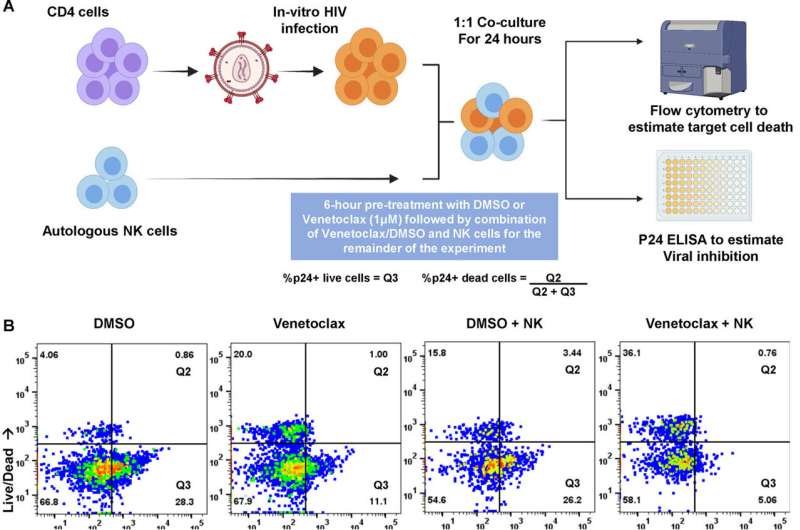This article has been reviewed according to Science X's editorial process and policies. Editors have highlighted the following attributes while ensuring the content's credibility:
fact-checked
peer-reviewed publication
trusted source
proofread
Unlocking the mechanisms of HIV in preclinical research

Mayo Clinic researchers have unraveled the molecular mechanisms that affect which cells infected with human immunodeficiency virus (HIV) die and which survive, a discovery heralded as a step toward eliminating all HIV-infected cells from the body.
This pioneering research goes beyond two common approaches to treating HIV infections. The first approach is to block HIV proteins, thereby preventing HIV cell replication. The second is to prevent HIV from reaching cells. However, neither treatment reduces the number of cells in the body that contain HIV, and these cells, also known as the HIV reservoir, are resistant to all current therapies.
"This research takes a new approach to eliminate HIV-infected cells. Our premise was that if we could understand how some HIV infected cells die following acute HIV infection, then we could design medical interventions which cause most HIV infected cells to die," says Andrew Badley, M.D., senior author of the study.
The findings of this decade-long Mayo Clinic research are published in the Journal of Virology.
Research to understand HIV proteins
The key to unlocking the mystery of what causes HIV-infected cells to die or survive is understanding how HIV proteins bind with other proteins inside the cell. When a cell is infected with HIV, that cell produces a protein called Casp8p41.
Previously the Mayo research team discovered that Casp8p41 causes the HIV-infected cell to die. However not all HIV-infected cells die because Casp8p41 can bind to a human protein called Bcl2, which neutralizes Casp8p41. The team discovered if Casp8p41 binds to Bcl2, then the HIV-infected cells survive. However, if Casp8p41 does not bind to Bcl2 then the infected cell dies, and the number of HIV-infected cells diminish.
"Our team found that what determines whether or not a cell lives or die is how much of those two proteins they have," says Dr. Badley.
Researchers applied this discovery to probe whether a Bcl2 inhibitor could eliminate HIV-infected cells in mouse models by blocking Bcl2 from binding to Casp8p41. Bcl2 inhibitors have shown similar properties against blood cancers.
This research demonstrated that the Bcl2 inhibitor has potential for killing infected cells, including "sleeper" cells that harbor HIV and reducing the HIV reservoir.
The Mayo Clinic team is one of the first, if not the first, to move this research into mice implanted with human immune systems and infected with HIV. Dr. Badley's team compared the cells of mice receiving the Bcl2 inhibitor to cells from a control group of mice without the inhibitor.
A disease with no cure
HIV causes acquired immunodeficiency syndrome (AIDS), a chronic, potentially life-threatening condition that destroys cells that coordinate the immune system, weakening it. HIV can be suppressed with combination of drugs, known as antiretroviral therapy, that reduces replication of HIV-infected cells. Antiretroviral therapy does not kill infected cells or reduce the size of the HIV reservoir, which could become active at any time, producing new HIV.
"Data in our study confirm meaningful anti-HIV effects of the Bcl2 inhibitor during HIV infection in humanized mouse models. Our hope is that this research will contribute to an eventual cure for HIV," says Dr. Badley.
More study is needed to confirm these findings.
More information: Aswath P. Chandrasekar et al, The BCL-2 Inhibitor Venetoclax Augments Immune Effector Function Mediated by Fas Ligand, TRAIL, and Perforin/Granzyme B, Resulting in Reduced Plasma Viremia and Decreased HIV Reservoir Size during Acute HIV Infection in a Humanized Mouse Model, Journal of Virology (2022). DOI: 10.1128/jvi.01730-22




















